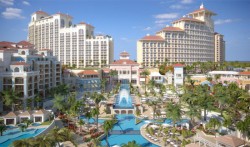With the airlift to The Bahamas surging way past the amount of available hotel rooms in the country, it bolsters the need even more for smaller hotel properties to fill in the gap, according to the President of the Bahamas Hotel Association Earl Bethel.
A steady demand for tourism means that business is booming at many local hotels.
He acknowledged that existing, larger resorts are unable to exclusively fulfill the demand for rooms.
“We find ourselves – and these are all the hotels – sold out to the point where we don’t have the availability to accommodate everybody,” said Mr. Bethel in an interview with the Bahama Journal.
“The main thing that we see coming on stream is that there is going to be even more airlift as we know this coming summer. With that in mind we will find ourselves in a position where there won’t be rooms available to accommodate all of these individuals,” he added.
Over the last several months a string of low cost air carriers and legacy airlines have either started or expanded service to The Bahamas. A few more including Virgin Airlines and American Eagle are slated to do the same this summer.
Currently, there is approximately 55 percent more airlift than available hotel rooms in The Bahamas. There are some 9,000 rooms available in New Providence, with only 15,000 in the entire country.
But with hotel developers on a tight schedule to complete existing projects around the islands, thousands more hotel rooms will become available within a few years.
The dilemma Mr. Bethel referred to, is that the need is more immediate.
The Minister of Tourism Obie Wilchcombe said in an earlier Journal interview that the problem being encountered is the result of a failure to plan.
He placed much stock in current projects related to the billion-dollar upgrade for Cable Beach and the redevelopment of southwest New Providence.
“We need more hotels to be built,” Mr. Wilchcombe said. “We need to have an assortment, like boutique hotels. We have to be able to offer the visitor the five star, the four star, the three star. We have to be able to ensure that everyone could come to The Bahamas because at the end of the day tourism is our number one industry.”
As far as Mr. Bethel sees it, the onus is also on local financial institutions to expand their lending portfolios to Bahamians who want to invest in small hotel properties.
“We need the banking institutions to make opportunities available for individuals -Bahamians- who want to invest in small hotel operations because that is one of the ways in which we will be able to alleviate the strain on the big hotels just carrying the brunt of it and having to rely on them also,” Mr. Bethel said.
Last September the tourism sector was dealt a heavy blow with the trail of destruction that Hurricanes Frances and Jeanne left behind, especially on the island of Grand Bahama.
The latest Central Bank of The Bahamas report noted that external sector inflows moderated as tourism activity in Grand Bahama remained significantly below trend.
The most recent data for January 2005 revealed that although tourist arrivals outpaced the previous year, air arrivals contracted, owing to a sizeable falloff in Grand Bahama.
But given the outlook for the continued expansion in tourism and foreign investments, the report said, support for the fiscal sector is expected to firm over the remainder of this fiscal year.
The Bahamas is marketed as a destination that caters to a wide range of discriminating tastes offering resorts like Nettie’s Place, a family operated, charming located on Cable Beach to the upscale Atlantis resort on Paradise Island.
By: Tameka Lundy, The Bahama Journal



